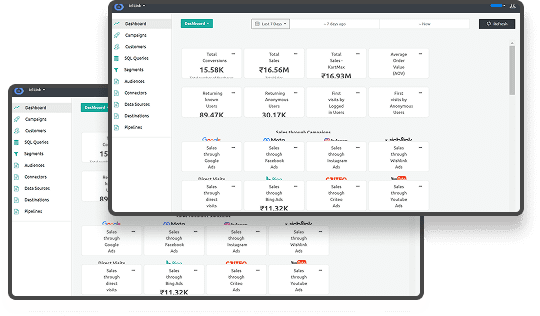TL;DR
- Privacy Compliance: As third-party cookies phase out, cookieless advertising focuses on privacy laws like GDPR and CCPA to protect consumer data.
- Utilize First-Party Data: Brands must use first-party data for personalized targeting, creating stronger, privacy-compliant customer relationships.
- Contextual Ads: Ads are now based on content relevance rather than user behavior, ensuring privacy while remaining impactful.
- Innovative Solutions: AI, machine learning, and privacy-friendly tracking technologies are essential for adapting to this new advertising landscape.
The world of online advertising is changing. For years, third-party cookies have been used to track customer behavior and target them with personalized ads.
However, with privacy concerns growing, many browsers, such as Safari, Firefox, Brave, and Google Chrome, are phasing out cookies. This shift means marketers need to rethink how they track and target their audience.
Cookieless advertising is quickly becoming the new norm, forcing advertisers and brands to rethink their strategies for tracking user behavior, personalizing content, and measuring the effectiveness of their campaigns.
Let’s look into this and understand how to turn this challenge into an opportunity for growth.
What is Cookieless Advertising?
Cookieless advertising refers to the practice of delivering personalized and targeted ads without relying on third-party cookies to track user behavior across websites and apps. Traditionally, cookies have been the go-to solution for advertisers to gather user data for ad targeting, retargeting, and analytics.
However, with growing concerns about data privacy and the introduction of stricter regulations like GDPR and CCPA, many browsers and platforms are phasing out third-party cookies.
In the absence of cookies, advertisers are now turning to alternative methods that are privacy-compliant and still enable them to effectively connect with their audiences. First-party data, contextual advertising, and privacy-friendly tracking tools have emerged as key solutions in this new landscape.
For more information on how privacy regulations are impacting advertising, check out our blog on Navigating Attribution in a Cookieless and Privacy-First World.
Now that we understand the concept of cookieless advertising, let’s explore why it’s becoming increasingly important for businesses today.
Why Cookieless Advertising is Important
The deprecation of cookies presents a unique challenge, but it also opens up a world of opportunities for businesses to rethink their approach to data collection, advertising, and consumer trust. Here are a few reasons why cookieless advertising is critical:
1. Changing Consumer Privacy Expectations
Consumers are increasingly concerned about their privacy and how their data is being used. With new laws like GDPR and CCPA, businesses must find ways to comply with data privacy regulations while still delivering effective advertising. Cookieless advertising ensures compliance by focusing on privacy-friendly methods.
2. Adapting to a Shifting Ecosystem
With the rise of iOS App Tracking Transparency (ATT) and Chrome's move toward phasing out third-party cookies, businesses that rely on cookies must adapt to the changing ecosystem or risk losing valuable consumer insights and targeting opportunities.
3. Increased Focus on First-Party Data
In a cookieless world, businesses will increasingly rely on first-party data (data collected directly from customers via interactions, purchases, or site visits) for targeting. This shift provides an opportunity to build deeper, more meaningful relationships with customers, as first-party data is more reliable and accurate.
For more on using first-party data to drive marketing efforts, check out our blog on Crafting Unique Experiences with First-Party Data.
To succeed in this new landscape, businesses must adopt key strategies that help them thrive without third-party cookies. Let’s look at some of the most effective methods.
Key Strategies for Thriving in Cookieless Advertising
The absence of third-party cookies doesn’t mean that digital advertising is doomed. In fact, it offers marketers the chance to innovate and find better, more effective ways to connect with consumers. Below are key strategies to help your business thrive in the era of cookieless advertising:
1. Embrace First-Party Data
First-party data is the cornerstone of cookieless advertising. This data is collected directly from your customers through interactions on your website, social media, or via email. The benefit of first-party data is that it’s more accurate, reliable, and compliant with privacy laws compared to third-party data.
Action Steps:
- Build customer profiles using first-party data (e.g., purchase history, browsing behavior on your site).
- Segment your audience to create personalized and targeted campaigns.
- Utilize your customer relationship management (CRM) to gather and organize data effectively.
For more insights on leveraging first-party data, explore our blog on Understanding First-Party, Second-Party, and Third-Party Data.
2. Contextual Advertising
In the absence of cookies, contextual advertising offers an effective alternative. Rather than targeting users based on their previous behavior, contextual ads are displayed based on the content the user is currently viewing. This method allows brands to reach users based on the relevance of the content rather than personal data, ensuring privacy compliance.
Action Steps:
- Utilize contextual targeting to display ads based on relevant keywords, topics, or the content's context.
- Invest in content partnerships and ad networks that allow for more precise contextual targeting.
To dive deeper into contextual advertising and its benefits, check out our blog on What is Programmatic Advertising and How Does It Work?.
3. Invest in Privacy-Compliant Tracking Technologies
As we move away from cookies, privacy-compliant tracking technologies are becoming more important. Tools like server-side tagging and consent management platforms allow businesses to track user interactions in a privacy-compliant manner, ensuring that customer data is collected and stored in accordance with regulations like GDPR and CCPA.
Action Steps:
- Implement server-side tagging to ensure accurate tracking while maintaining data privacy.
- Use consent management tools to ensure that users have control over their data and are informed about how their data is being used.
For more on privacy-compliant data tracking, read our blog on What You Need to Know About Consent Management.
4. Explore the Power of Artificial Intelligence (AI) and Machine Learning
AI and machine learning technologies can help marketers deliver effective ads in a cookieless world by analyzing large sets of data to predict user behavior and personalize content. These tools can help advertisers improve targeting and optimize their campaigns, even without relying on cookies.
Action Steps:
- Leverage AI-driven analytics to make data-driven decisions for targeting and personalization.
- Use machine learning algorithms to predict customer preferences and optimize ad spend.
For insights into how AI is transforming the advertising landscape, check out our blog on AI-first Lead Management Software.
5. Leverage Identity Graphs and Customer Data Platforms (CDPs)
An identity graph helps marketers understand and track users across multiple devices and touchpoints without the use of cookies. By consolidating first-party data, businesses can create a unified customer profile that allows for better targeting and personalization. Customer Data Platforms (CDPs) also help unify customer data from multiple sources to create a holistic view of the customer journey.
Action Steps:
- Integrate a Customer Data Platform (CDP) to aggregate first-party data from different sources.
- Build identity graphs to track and understand customers’ behavior across multiple touchpoints.
For more on building effective data infrastructure, check out our blog on Developing Best Practices for First-Party Identity Infrastructure.
Leveraging first-party data is at the core of cookieless advertising, but it’s crucial to understand how to make the most of this valuable asset.
Ways to Utilize First-Party Data Strategically
First-party data is your most valuable asset in cookieless advertising. It’s data you own, and it’s more accurate and compliant with privacy laws. Here’s how you can leverage it effectively:
1. Build Customer Profiles
Use first-party data to create detailed customer profiles. This can include purchase history, browsing behavior, and engagement with your content. These profiles help you deliver personalized, relevant ads without relying on third-party cookies.
2. Segment Your Audience
Once you have customer profiles, you can segment your audience based on different behaviors and preferences. For example, you might segment by:
- Purchase frequency
- Location
- Product interests
This helps you deliver more targeted ads that resonate with each audience segment.
For more on audience segmentation, check out our blog on Understanding Multi-Touch vs. Last-Touch Attribution.
3. Offer Value in Exchange for Data
Encourage customers to share their data by offering value in return. This could be discounts, exclusive content, or loyalty programs. Building trust through transparent data practices will help you collect high-quality first-party data.
As you leverage first-party data, it’s essential to prepare your business for the cookieless future. Let’s explore how you can ensure your business is ready for the changes ahead.
Preparing Your Business for the Cookieless Future
As cookieless advertising becomes the new standard, businesses need to prepare for the future. Here’s how:
1. Invest in First-Party Data Collection
Start building your first-party data now. Offer incentives to customers in exchange for their data and ensure that you’re collecting information across different touchpoints (website, social media, email).
2. Keep up with Privacy Regulations
With privacy laws evolving, it’s important to stay updated on the latest changes and ensure your advertising practices comply with regulations like GDPR and CCPA.
3. Test and Optimize Your Strategies
As you transition to cookieless advertising, continually test your new strategies and make adjustments based on performance. Experiment with different advertising methods, like contextual ads and first-party data targeting, to see what works best for your audience.
Now that you’re prepared for the cookieless future, let’s explore some of the common challenges businesses face and how to tackle them.
Challenges and Solutions in a Cookieless World
Moving away from cookies comes with its set of challenges, but these can be overcome with the right strategies. Common challenges include:
1. Lack of Cross-Device Tracking
Without cookies, tracking users across devices becomes harder. However, using identity graphs and first-party data can help you track customers more accurately.
2. Privacy Concerns
While consumers demand more privacy, businesses must balance privacy with personalization. Focusing on first-party data and contextual advertising allows you to respect privacy while still targeting customers effectively.
For more on this, read our blog on Understanding Cookieless Attribution and Its Functioning in Marketing.
Overcoming these challenges is crucial, and Ingest Labs offers the tools you need to navigate this new landscape. Let’s take a look at how we can assist your business.
How Ingest Labs Helps
At Ingest Labs, we specialize in helping businesses adapt to cookieless advertising by offering advanced tracking solutions Ingest ID, real-time data monitoring, and privacy-compliant tools.
1. Real-Time Data Monitoring
We provide real-time insights into your digital marketing campaigns, allowing you to monitor performance without relying on cookies. This helps you optimize your ad strategies based on accurate, privacy-friendly data.
2. Server-Side Tagging
Our server-side tagging solution ( Ingest IQ) helps you track user interactions with greater accuracy while maintaining data privacy. This ensures you’re collecting high-quality, first-party data for your campaigns.
For more on server-side tagging, check out our blog on Server-Side Tagging: Why It’s Time to Shift the Game.
With our solutions in place, you’re ready to thrive in a cookieless advertising world.
Conclusion
As the world of digital advertising moves toward a cookieless future, it’s important for businesses to adapt and find new ways to connect with their audiences. By focusing on first-party data, contextual advertising, and privacy-compliant tracking, you can continue to deliver personalized ads while respecting your customers’ privacy.
Ingest Labs offers a suite of solutions to help you thrive in the era of cookieless advertising, from data tracking and server-side tagging to advanced AI-driven tools. Let us help you navigate the cookieless world and ensure that your marketing strategy remains effective and compliant with privacy regulations.
Ready to adapt to cookieless advertising and improve your marketing strategies? Contact Ingest Labs today to learn more about how we can help you thrive in the evolving digital landscape.
FAQ
1 What is cookieless advertising?
Cookieless advertising refers to targeting and delivering personalized ads without using third-party cookies to track user behavior, relying instead on privacy-compliant methods like first-party data and contextual advertising.
2 What is cookie-based advertising?
Cookie-based advertising uses third-party cookies to track users' online behavior across websites, allowing advertisers to target them with personalized ads based on their browsing history.
3 Is cookieless tracking legal?
Yes, cookieless tracking is legal as long as it complies with privacy regulations such as GDPR and CCPA, which require businesses to protect user data and obtain proper consent.
4 What is cookieless attribution in marketing?
Cookieless attribution is the process of measuring and attributing marketing efforts and conversions without relying on cookies, often using first-party data or alternative tracking methods.
5 What is the difference between cookieless and cookie?
The main difference is that cookie-based advertising uses third-party cookies to track user behavior across websites, while cookieless advertising relies on privacy-friendly alternatives like first-party data, contextual targeting, and consent-based methods.
6 What is an example of attribution in advertising?
An example of attribution in advertising is tracking which ad, from a series of ads, led a user to make a purchase, even if no cookies were used, by relying on user interactions, CRM data, or other identifiers.






